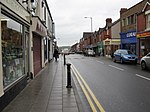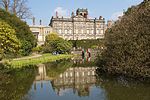Braddocks Hay
BiddulphStaffordshire geography stubsVillages in Staffordshire
Braddocks Hay is a village in Staffordshire, England. Population details for the 2011 census can be found under Biddulph
Excerpt from the Wikipedia article Braddocks Hay (License: CC BY-SA 3.0, Authors).Braddocks Hay
Tunstall Road, Staffordshire Moorlands Knowle Style
Geographical coordinates (GPS) Address Nearby Places Show on map
Geographical coordinates (GPS)
| Latitude | Longitude |
|---|---|
| N 53.11 ° | E -2.18 ° |
Address
Tunstall Road
ST8 7FR Staffordshire Moorlands, Knowle Style
England, United Kingdom
Open on Google Maps






